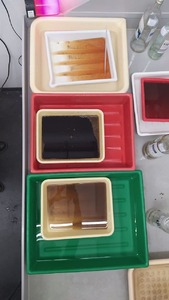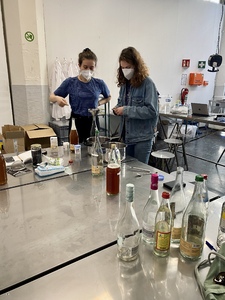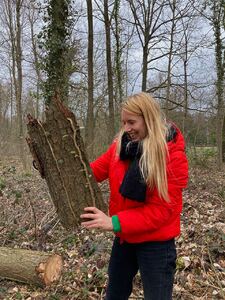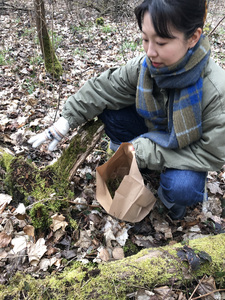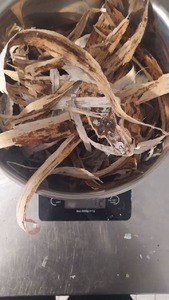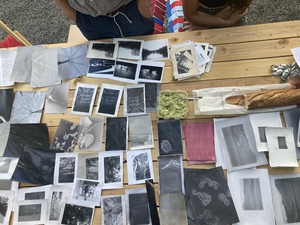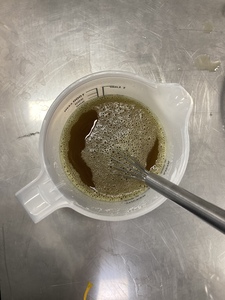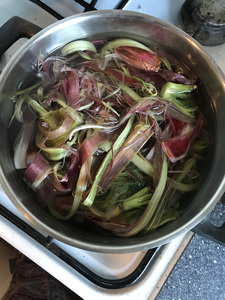"HfG Website"
| Begriff | HfG Website |
| Metakey | Freigabe Nutzung HfG (rights:usage_hfg) |
| Typ | Keyword |
| Vokabular | Rechte |
1829 Inhalte
- Seite 1 von 153
Photosymbiosen – On Co-Developing with Plant Accomplices
- Titel
- Photosymbiosen – On Co-Developing with Plant Accomplices
- Titel (en)
- Photosymbiosen – On Co-Developing with Plant Accomplices
- Untertitel
- Sustainable Photography
- Beschreibung (de)
- Dokumentation der Recherche für das Projekt „Photosymbiosen – On Co-Developing with Plant Accomplices“.
- Beschreibung (en)
- Documentation of research for the project "Photosymbioses - On Co-Developing with Plant Accomplices".
- Typ des Projekts/Werks
- Schlagworte
- Datierung
- Sommersemester 2021
- Mitwirkende
- Material
- Ort: Institution
- Stadt
- Land
- Internetlinks
- Titel
- Photosymbiosen – On Co-Developing with Plant Accomplices
- Urheberrechtshinweis
- Bio Design Lab
- Rechtsschutz/Lizenz
- Freigabe Nutzung HfG
- Semester
- Importiert am
- 30.10.2023
- Übergeordnete Sets
- 1
Photosymbiosen – On Co-Developing with Plant Accomplices
- Titel
- Photosymbiosen – On Co-Developing with Plant Accomplices
- Titel (en)
- Photosymbiosen – On Co-Developing with Plant Accomplices
- Untertitel
- Sustainable Photography
- Beschreibung (de)
- Dokumentation der Recherche für das Projekt „Photosymbiosen – On Co-Developing with Plant Accomplices“.
- Beschreibung (en)
- Documentation of research for the project "Photosymbioses - On Co-Developing with Plant Accomplices".
- Typ des Projekts/Werks
- Schlagworte
- Datierung
- Sommersemester 2021
- Mitwirkende
- Material
- Ort: Institution
- Stadt
- Land
- Internetlinks
- Titel
- Photosymbiosen – On Co-Developing with Plant Accomplices
- Urheberrechtshinweis
- Bio Design Lab
- Rechtsschutz/Lizenz
- Freigabe Nutzung HfG
- Semester
- Importiert am
- 30.10.2023
- Übergeordnete Sets
- 1
Photosymbiosen – On Co-Developing with Plant Accomplices
- Titel
- Photosymbiosen – On Co-Developing with Plant Accomplices
- Titel (en)
- Photosymbiosen – On Co-Developing with Plant Accomplices
- Untertitel
- Sustainable Photography
- Beschreibung (de)
- Dokumentation der Recherche für das Projekt „Photosymbiosen – On Co-Developing with Plant Accomplices“.
- Beschreibung (en)
- Documentation of research for the project "Photosymbioses - On Co-Developing with Plant Accomplices".
- Typ des Projekts/Werks
- Schlagworte
- Datierung
- Sommersemester 2021
- Mitwirkende
- Material
- Ort: Institution
- Stadt
- Land
- Internetlinks
- Titel
- Photosymbiosen – On Co-Developing with Plant Accomplices
- Urheberrechtshinweis
- Bio Design Lab
- Rechtsschutz/Lizenz
- Freigabe Nutzung HfG
- Semester
- Importiert am
- 30.10.2023
- Übergeordnete Sets
- 1
Photosymbiosen – On Co-Developing with Plant Accomplices
- Titel
- Photosymbiosen – On Co-Developing with Plant Accomplices
- Titel (en)
- Photosymbiosen – On Co-Developing with Plant Accomplices
- Untertitel
- Sustainable Photography
- Beschreibung (de)
- Dokumentation der Recherche für das Projekt „Photosymbiosen – On Co-Developing with Plant Accomplices“.
- Beschreibung (en)
- Documentation of research for the project "Photosymbioses - On Co-Developing with Plant Accomplices".
- Typ des Projekts/Werks
- Schlagworte
- Datierung
- Sommersemester 2021
- Mitwirkende
- Material
- Ort: Institution
- Stadt
- Land
- Internetlinks
- Titel
- Photosymbiosen – On Co-Developing with Plant Accomplices
- Urheberrechtshinweis
- Bio Design Lab
- Rechtsschutz/Lizenz
- Freigabe Nutzung HfG
- Semester
- Importiert am
- 30.10.2023
- Übergeordnete Sets
- 1
Photosymbiosen – On Co-Developing with Plant Accomplices
- Titel
- Photosymbiosen – On Co-Developing with Plant Accomplices
- Titel (en)
- Photosymbiosen – On Co-Developing with Plant Accomplices
- Untertitel
- Sustainable Photography
- Beschreibung (de)
- Dokumentation der Recherche für das Projekt „Photosymbiosen – On Co-Developing with Plant Accomplices“.
- Beschreibung (en)
- Documentation of research for the project "Photosymbioses - On Co-Developing with Plant Accomplices".
- Typ des Projekts/Werks
- Schlagworte
- Datierung
- Sommersemester 2021
- Mitwirkende
- Material
- Ort: Institution
- Stadt
- Land
- Internetlinks
- Titel
- Photosymbiosen – On Co-Developing with Plant Accomplices
- Urheberrechtshinweis
- Bio Design Lab
- Rechtsschutz/Lizenz
- Freigabe Nutzung HfG
- Semester
- Importiert am
- 30.10.2023
- Übergeordnete Sets
- 1
Photosymbiosen – On Co-Developing with Plant Accomplices
- Titel
- Photosymbiosen – On Co-Developing with Plant Accomplices
- Titel (en)
- Photosymbiosen – On Co-Developing with Plant Accomplices
- Untertitel
- Sustainable Photography
- Beschreibung (de)
- Dokumentation der Recherche für das Projekt „Photosymbiosen – On Co-Developing with Plant Accomplices“.
- Beschreibung (en)
- Documentation of research for the project "Photosymbioses - On Co-Developing with Plant Accomplices".
- Typ des Projekts/Werks
- Schlagworte
- Datierung
- Sommersemester 2021
- Mitwirkende
- Material
- Ort: Institution
- Stadt
- Land
- Internetlinks
- Titel
- Photosymbiosen – On Co-Developing with Plant Accomplices
- Urheberrechtshinweis
- Bio Design Lab, Minhee Oh
- Rechtsschutz/Lizenz
- Freigabe Nutzung HfG
- Semester
- Importiert am
- 30.10.2023
- Übergeordnete Sets
- 1
Photosymbiosen – On Co-Developing with Plant Accomplices
- Titel
- Photosymbiosen – On Co-Developing with Plant Accomplices
- Titel (en)
- Photosymbiosen – On Co-Developing with Plant Accomplices
- Untertitel
- Sustainable Photography
- Beschreibung (de)
- Dokumentation der Recherche für das Projekt „Photosymbiosen – On Co-Developing with Plant Accomplices“.
- Beschreibung (en)
- Documentation of research for the project "Photosymbioses - On Co-Developing with Plant Accomplices".
- Typ des Projekts/Werks
- Schlagworte
- Datierung
- Sommersemester 2021
- Mitwirkende
- Material
- Ort: Institution
- Stadt
- Land
- Internetlinks
- Titel
- Photosymbiosen – On Co-Developing with Plant Accomplices
- Urheberrechtshinweis
- Bio Design Lab
- Rechtsschutz/Lizenz
- Freigabe Nutzung HfG
- Semester
- Importiert am
- 30.10.2023
- Übergeordnete Sets
- 1
Photosymbiosen – On Co-Developing with Plant Accomplices
- Titel
- Photosymbiosen – On Co-Developing with Plant Accomplices
- Titel (en)
- Photosymbiosen – On Co-Developing with Plant Accomplices
- Untertitel
- Sustainable Photography
- Beschreibung (de)
- Dokumentation der Recherche für das Projekt „Photosymbiosen – On Co-Developing with Plant Accomplices“.
- Beschreibung (en)
- Documentation of research for the project "Photosymbioses - On Co-Developing with Plant Accomplices".
- Typ des Projekts/Werks
- Schlagworte
- Datierung
- Sommersemester 2021
- Mitwirkende
- Material
- Ort: Institution
- Stadt
- Land
- Internetlinks
- Titel
- Photosymbiosen – On Co-Developing with Plant Accomplices
- Urheberrechtshinweis
- Bio Design Lab, Minhee Oh
- Rechtsschutz/Lizenz
- Freigabe Nutzung HfG
- Semester
- Importiert am
- 30.10.2023
- Übergeordnete Sets
- 1
Photosymbiosen – On Co-Developing with Plant Accomplices
- Titel
- Photosymbiosen – On Co-Developing with Plant Accomplices
- Titel (en)
- Photosymbiosen – On Co-Developing with Plant Accomplices
- Untertitel
- Sustainable Photography
- Beschreibung (de)
- Dokumentation der Recherche für das Projekt „Photosymbiosen – On Co-Developing with Plant Accomplices“.
- Beschreibung (en)
- Documentation of research for the project "Photosymbioses - On Co-Developing with Plant Accomplices".
- Typ des Projekts/Werks
- Schlagworte
- Datierung
- Sommersemester 2021
- Mitwirkende
- Material
- Ort: Institution
- Stadt
- Land
- Internetlinks
- Titel
- Photosymbiosen – On Co-Developing with Plant Accomplices
- Urheberrechtshinweis
- Bio Design Lab, Minhee Oh
- Rechtsschutz/Lizenz
- Freigabe Nutzung HfG
- Semester
- Importiert am
- 30.10.2023
- Übergeordnete Sets
- 1
Photosymbiosen – On Co-Developing with Plant Accomplices
- Titel
- Photosymbiosen – On Co-Developing with Plant Accomplices
- Titel (en)
- Photosymbiosen – On Co-Developing with Plant Accomplices
- Untertitel
- Sustainable Photography
- Beschreibung (de)
- Dokumentation der Recherche für das Projekt „Photosymbiosen – On Co-Developing with Plant Accomplices“.
- Beschreibung (en)
- Documentation of research for the project "Photosymbioses - On Co-Developing with Plant Accomplices".
- Typ des Projekts/Werks
- Schlagworte
- Datierung
- Sommersemester 2021
- Mitwirkende
- Material
- Ort: Institution
- Stadt
- Land
- Internetlinks
- Titel
- Photosymbiosen – On Co-Developing with Plant Accomplices
- Urheberrechtshinweis
- Bio Design Lab
- Rechtsschutz/Lizenz
- Freigabe Nutzung HfG
- Semester
- Importiert am
- 30.10.2023
- Übergeordnete Sets
- 1
Photosymbiosen – On Co-Developing with Plant Accomplices
- Titel
- Photosymbiosen – On Co-Developing with Plant Accomplices
- Titel (en)
- Photosymbiosen – On Co-Developing with Plant Accomplices
- Untertitel
- Sustainable Photography
- Beschreibung (de)
- Dokumentation der Recherche für das Projekt „Photosymbiosen – On Co-Developing with Plant Accomplices“.
- Beschreibung (en)
- Documentation of research for the project "Photosymbioses - On Co-Developing with Plant Accomplices".
- Typ des Projekts/Werks
- Schlagworte
- Datierung
- Sommersemester 2021
- Mitwirkende
- Material
- Ort: Institution
- Stadt
- Land
- Internetlinks
- Titel
- Photosymbiosen – On Co-Developing with Plant Accomplices
- Urheberrechtshinweis
- Bio Design Lab
- Rechtsschutz/Lizenz
- Freigabe Nutzung HfG
- Semester
- Importiert am
- 30.10.2023
- Übergeordnete Sets
- 1
Photosymbiosen – On Co-Developing with Plant Accomplices
- Titel
- Photosymbiosen – On Co-Developing with Plant Accomplices
- Titel (en)
- Photosymbiosen – On Co-Developing with Plant Accomplices
- Untertitel
- Sustainable Photography
- Beschreibung (de)
- Dokumentation der Recherche für das Projekt „Photosymbiosen – On Co-Developing with Plant Accomplices“.
- Beschreibung (en)
- Documentation of research for the project "Photosymbioses - On Co-Developing with Plant Accomplices".
- Typ des Projekts/Werks
- Schlagworte
- Datierung
- Sommersemester 2021
- Mitwirkende
- Material
- Ort: Institution
- Stadt
- Land
- Internetlinks
- Titel
- Photosymbiosen – On Co-Developing with Plant Accomplices
- Urheberrechtshinweis
- Bio Design Lab
- Rechtsschutz/Lizenz
- Freigabe Nutzung HfG
- Semester
- Importiert am
- 30.10.2023
- Übergeordnete Sets
- 1
